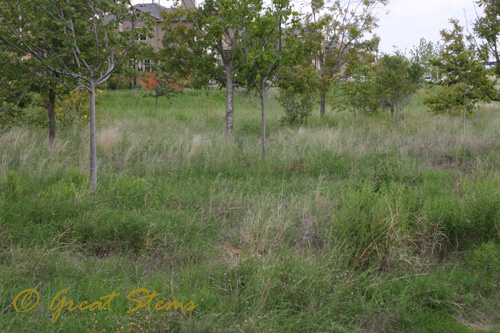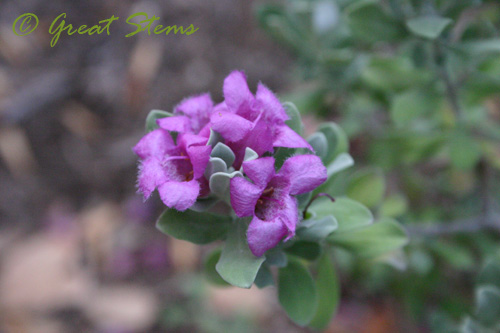Ahhh, the Texas Rock Rose (Pavonia lasiopetala). Such a favorite. It's also known as Rose Pavonia and Rose Mallow. This gorgeous perennial is native to Texas and Mexico, but it is part of a larger family that has species native to various countries. Texas Rock Rose loves limestone-filled clay soil and doesn't mind the drought, which is good because I have plenty of both. And the little flowers really stand out against the limestone rocks of my pond and my stone house, looking like a miniature hibiscus or wild rose. But each individual part of the rock rose is as beautiful and fascinating as the rest. And as it turns out, the rock rose is a great plant to use for a lesson in flower anatomy.
Texas Rock Rose, like other flowering plants, is an angiosperm. In this case, it's considered a short-lived flowering perennial.
Each young bud is surrounded by green bracts, or modified leaves. The long, skinny bracts start out parallel to the bud, but then open up to reveal a whorl of green wider modified leaves called sepals.
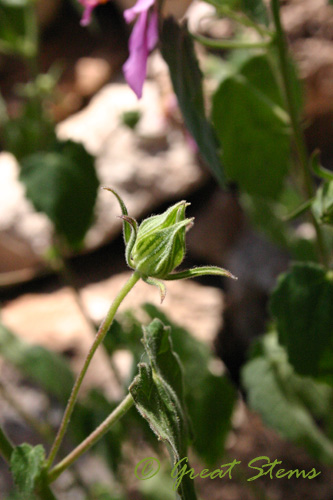
You can see that the whorl of sepals is in a group of five. The sepals form a star when they open. The rock rose shows off this star shape again and again. It's a rock star! (Did you just groan? I heard that.)
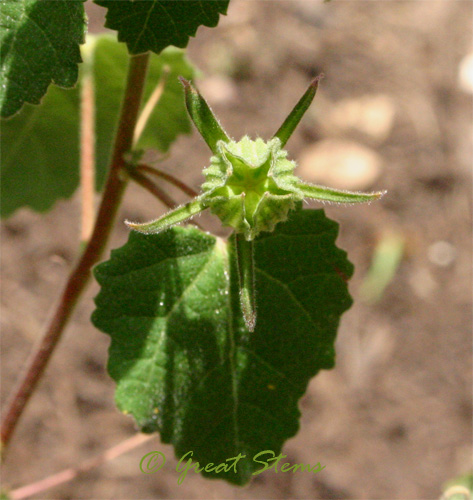 Despite my bad joke, the fact that the flower parts are in multiples of five is actually important. This indicates that the rock rose can be classified as a eudicot, one of the groups of angiosperms.
Despite my bad joke, the fact that the flower parts are in multiples of five is actually important. This indicates that the rock rose can be classified as a eudicot, one of the groups of angiosperms.
When the bud opens, the sepals are almost flat. They remain to protect and support the flower. Being green, they also contribute to photosynthesis. Together, the whorl of sepals is called the calyx. A star-shaped calyx. :)
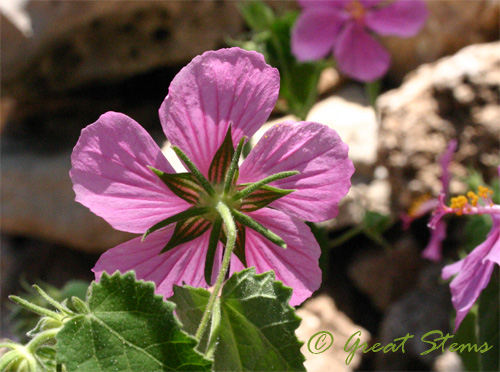
One reason I am drawn to this star theme is because Texas is known as the Lone Star State, making the star shapes in the flower very appropriate. But who can resist the way nature can produce such a perfect five-pointed star again and again?
As the sepals open, you begin to see the pink within. In this picture you can see a closed bud, an opening new bud, and an existing flower that has closed up. The rock rose flowers react to both temperature and light -- they will close up in the hottest part of the day and when it is dark.
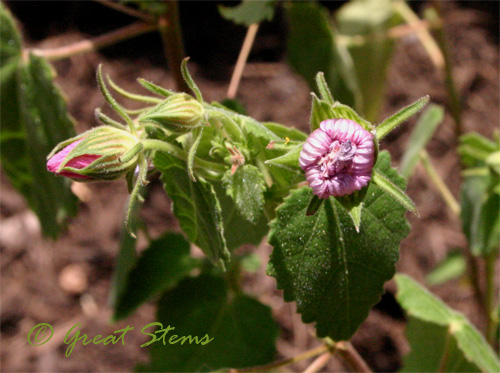 When the bud opens to reveal the flower, you can see the whorl of five pink petals. This whorl is called the corolla. Some corollas are fused, but in the rock rose, the five petals are distinct. The rock rose also only has a single whorl of petals -- some other flowers have a double whorl. The calyx (sepals) and corolla (petals) together form the perianth.
When the bud opens to reveal the flower, you can see the whorl of five pink petals. This whorl is called the corolla. Some corollas are fused, but in the rock rose, the five petals are distinct. The rock rose also only has a single whorl of petals -- some other flowers have a double whorl. The calyx (sepals) and corolla (petals) together form the perianth.
The bright pink flowers help to attract pollinators to the reproductive unit of the flowers. The rock rose flower is "perfect" in terms of botany; it has both male and female parts. Plants like these are also called hermaphroditic, or bisexual. They can self-fertilize or be pollinated by insects or wind, or at my house by getting brushed up against by dogs.
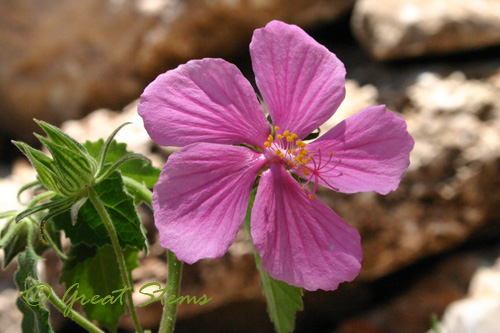
It's hard to miss the bright yellow pollen of the rock rose. But if you look closely at the pollen, you will see that the grains are clumped at the end of tiny pink filaments. The anther at the end of a filament produces the pollen. The filament and anther together form the stamen. The filaments are attached to the stamen tube, or staminal column, seen here as a white cylinder. All these parts together form the male part of the flower.
It is interesting to note that the plentiful pollen of the rock rose is sometimes gathered for its Vitamin E and other health benefits.
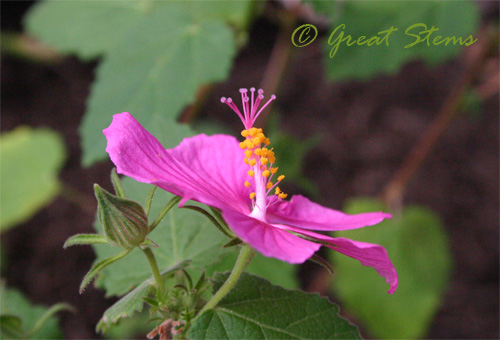
In the rock rose, the female structures are mostly hidden inside the staminal column. The female structures are collectively called the pistil. You can see the sticky stigmas protruding from the stamen tube. Some stigmas have little hairs on them. The stigmas are at the ends of the female tube, called a style. At the base of the style, the ovary contains the ovules, which in turn contain the female egg producers.
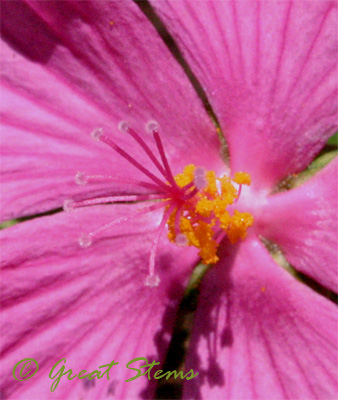 The pollen lands on the stigma and germinates, growing a pollen tube down the style to the ovary and ovules. The sperm travel from the pollen down the pollen tube to fertilize the eggs within the ovules. And with a number of divisions, a seed is born! In the case of the rock rose, I understand the plant is a happy seed producer, to the dismay of some gardeners. At the moment, I don't mind if it spreads some. I have room.
The pollen lands on the stigma and germinates, growing a pollen tube down the style to the ovary and ovules. The sperm travel from the pollen down the pollen tube to fertilize the eggs within the ovules. And with a number of divisions, a seed is born! In the case of the rock rose, I understand the plant is a happy seed producer, to the dismay of some gardeners. At the moment, I don't mind if it spreads some. I have room.
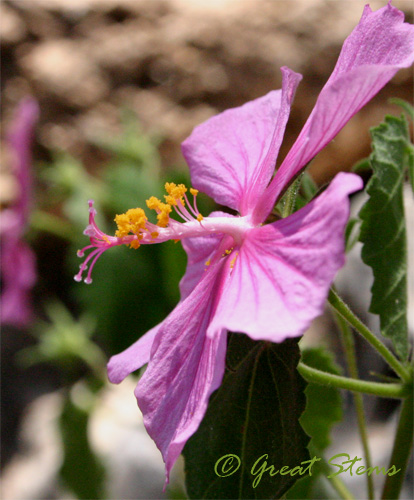
In this photograph, you can see that some pollen grains have landed and adhered to a couple of stigmas.
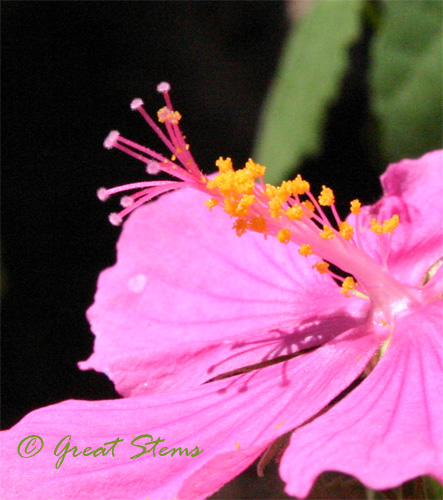 Turning attention to the green portion of the plant, the lightly-toothed, velvety leaves of the Texas Rock Rose form an alternate pattern on the stem. I find it interesting that a single bud and leaf "stem" from the same node on the main stem.
Turning attention to the green portion of the plant, the lightly-toothed, velvety leaves of the Texas Rock Rose form an alternate pattern on the stem. I find it interesting that a single bud and leaf "stem" from the same node on the main stem.
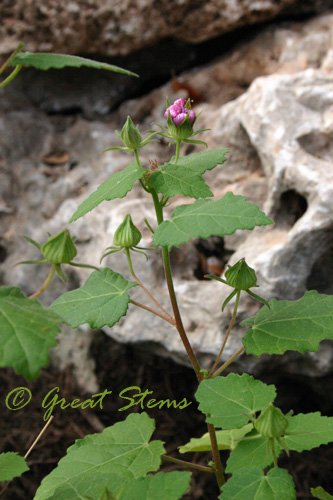 I recently added another species of rock rose to the garden as well, Brazilian Rock Rose (Pavonia braziliensis). If it starts to gets out of control, too, I'll give priority to the native variety. Pretty white flower, you have been warned!
I recently added another species of rock rose to the garden as well, Brazilian Rock Rose (Pavonia braziliensis). If it starts to gets out of control, too, I'll give priority to the native variety. Pretty white flower, you have been warned!
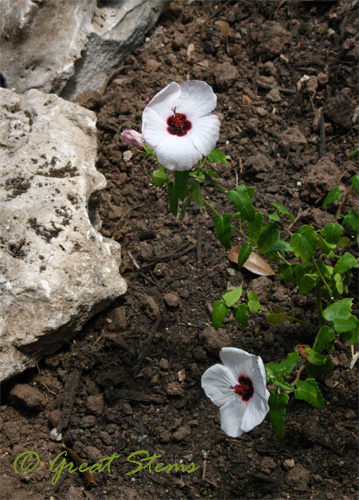 The burgundy center provides quite the contrast to the white corolla. The petals are larger than that of the Texas Rock Rose, giving the corolla a more rounded appearance. From the back (see the crumpled petals in the background), the petals have a similar pink vein to that of the Texas Rock Rose.
The burgundy center provides quite the contrast to the white corolla. The petals are larger than that of the Texas Rock Rose, giving the corolla a more rounded appearance. From the back (see the crumpled petals in the background), the petals have a similar pink vein to that of the Texas Rock Rose.
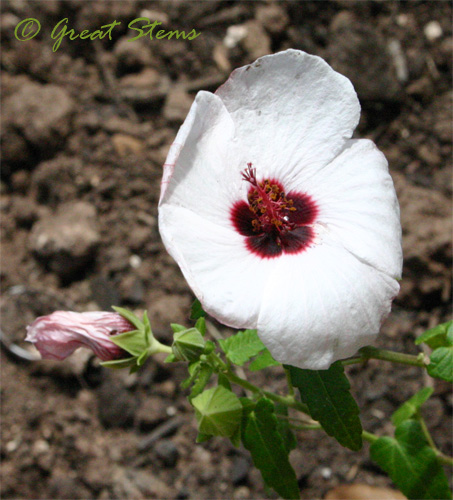
Hey, even the burgundy forms a star shape!
Whatever the flower parts, whatever the species, the rock rose is beautiful. Dare I say, it's a star.
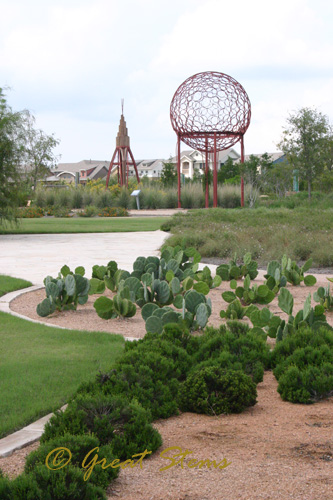 Gregg's Dalea...
Gregg's Dalea...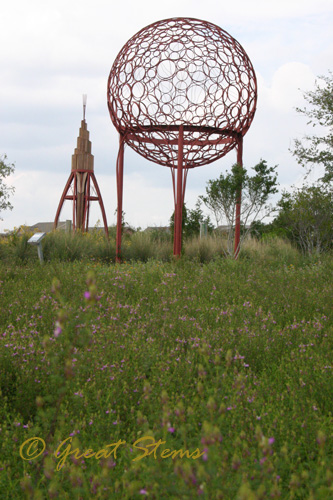 Prickly Pear, Lindheimer's Muhly, Salvia, Lindheimer Senna...
Prickly Pear, Lindheimer's Muhly, Salvia, Lindheimer Senna...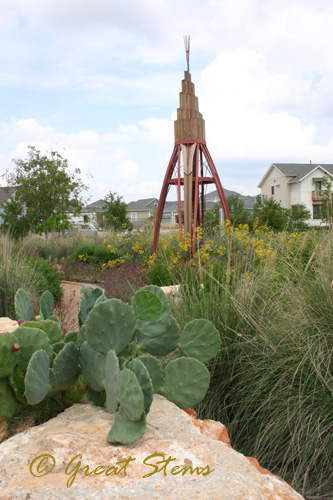 Lindheimer Senna...
Lindheimer Senna...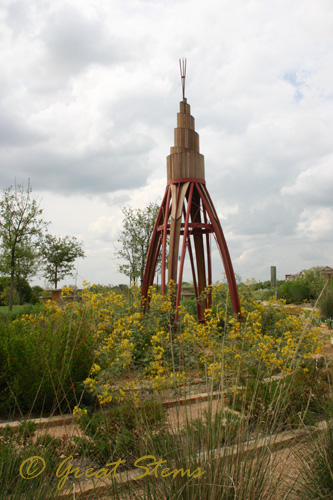 Flame Acanthus, Lindheimer Senna, Salvia
Flame Acanthus, Lindheimer Senna, Salvia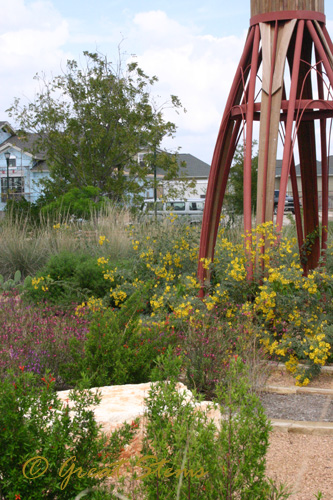 I fell in love with this mixture of Salvia greggii colors.
I fell in love with this mixture of Salvia greggii colors.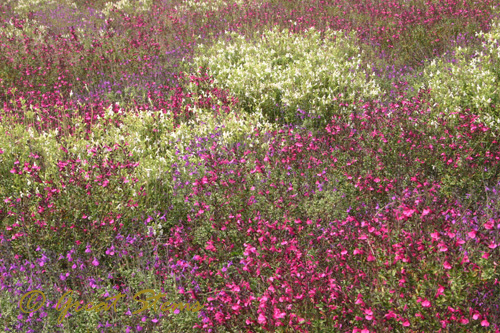
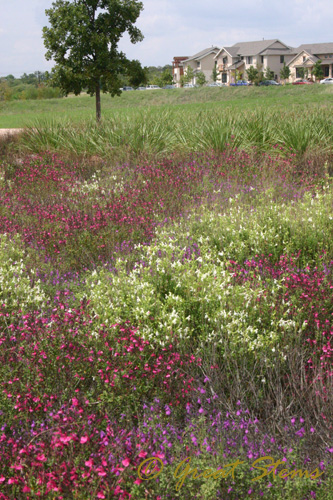 Inland Sea Oats in front of American Beautyberry...
Inland Sea Oats in front of American Beautyberry...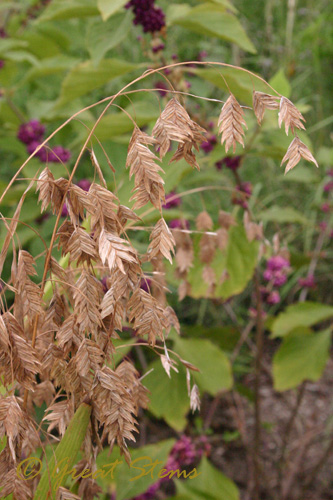 Walkway under Desert Willows...
Walkway under Desert Willows...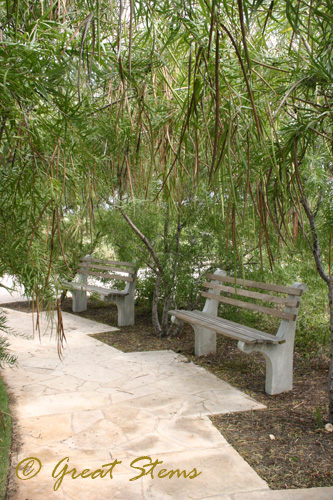 A view of the three ponds, surrounded by native grasses...
A view of the three ponds, surrounded by native grasses...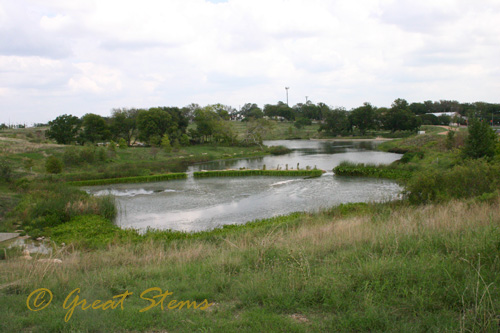 One of the grassland prairies...
One of the grassland prairies... 